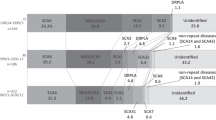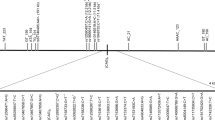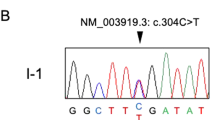Abstract
Dentatorubropallidoluysian atrophy (DRPLA) is an autosomal dominant neurodegenerative disorder characterized by a variable combination of progressive ataxia, epilepsy, myoclonus, choreoathetosis and dementia. This disease is caused by a (CAG)n expansion in the DRPLA gene, on chromosome 12p13. DRPLA is prevalent in Japan, but several families of non-Japanese ancestry have already been published. To identify the origin of expanded alleles in Portuguese families with DRPLA, we studied two previously reported intragenic SNPs in introns 1 and 3, in addition to the CAG repeat of the DRPLA gene. The results showed that all four Portuguese DRPLA families shared the same haplotype, which is also common to that reported for Japanese DRPLA chromosomes. This haplotype is also the most frequent in Japanese normal alleles, whereas it was rare in Portuguese control chromosomes. Thus, our findings support that a founder DRPLA haplotype of Asian origin was introduced in Portugal, being responsible for the frequency of the disease in this country.
Similar content being viewed by others
Introduction
Dentatorubropallidoluysian atrophy (DRPLA) is an autosomal dominant neurodegenerative disease characterized by a variable combination of progressive ataxia, epilepsy, myoclonus, choreoathetosis and dementia.1 This disease is caused by a (CAG)n expansion in the coding region of a gene on chromosome 12p13.2 Normal alleles have usually up to 35 repeats and are highly polymorphic, whereas pathological alleles have 40–100 CAG repeats, and show somatic mosaicism and intergenerational instability, mainly upon paternal transmission.3 The DRPLA mutation is most prevalent in Japan, but several families of non-Japanese ancestry have been identified.4,5,6,7 Expanded DRPLA alleles of Asian and Caucasian ancestry all share a common haplotype, which is also associated with larger normal alleles commonly found in Asians.3 Association between prevalence of dominantly inherited SCAs and the frequency of large normal alleles indicated that these may contribute to the generation of expanded alleles.7 In Portugal, we have identified four families with DRPLA, but no association between the frequency of the DRPLA mutation and the frequency of large normal alleles has been found.8 To identify the origin of expanded DRPLA alleles in the Portuguese families, we performed a haplotype analysis with three intragenic DRPLA polymorphisms, in both disease and control chromosomes of Portuguese origin.
Subjects and methods
Genomic DNA from four Portuguese families with DRPLA and 20 control families was obtained as previously reported,9 after written informed consent was given. As far as we know, these families are not related to each other and do not have known Asian ancestry.
PCR reactions to detect the A and B polymorphic sites and the CAG repeat in the DRPLA gene were performed with primers previously described.3 Figure 1 is a schematic representation of the studied polymorphic sites in the DRPLA gene. PCR was carried out with 1 μ M of each primer; 200 μ M of dNTPs; 1 mM MgCl2; 10 mM Tris, pH 9.0; 50 mM KCl; 1 U of Taq polymerase, and 2% formamide, in a final volume of 25 μl. The A polymorphic system results from a single A1010G variant in intron 1 at approximately 3500 bp from the (CAG)n in exon 5. We used the same system as Yanagisawa et al,3 naming alleles A1 and A2 when base A or G was present, respectively. The B polymorphic system is due to a T1865C substitution in intron 3, at approximately 2500 bp from the CAG repeat; alleles have also been named B1 and B2 for the presence of base T or C, respectively, according to Yanagisawa et al.3 The A system was assessed by SSCP analysis, after PCR amplification with primers DALUR and SNP-A-F (5′-CCACCTAGGCCTCCCAAAGTGC-3′). The B system was amplified by PCR, with primers DGTF and DGTR, prior to its typing by SSCP analysis. Whenever required, the phase between the polymorphic system A and the (CAG)n was determined by cloning PCR products of primers DALUF and DR2124, encompassing the A, B and (CAG)n polymorphisms, using the TOPO TA cloning Kit (Invitrogen). The CAG repeat size was assessed by PCR, with primers CTG-B37F and CTG-B37R, followed by electrophoresis of the resulting products in a 6% polyacrylamide gel. The polymorphism for the A system was identified by sequencing with primer DALUR. Allele-specific PCR reactions, with primers Eco81I T or Eco81I C and DR2124, were performed to determine the phase for the B polymorphic system and the CAG repeat. Then, CAG repeat sizes were assessed in each PCR product.
Schematic representation of the A, B and (CAG)n repeat polymorphisms in the DRPLA gene. The line on top shows the position of the three polymorphic sites A, B and CAG repeat polymorphisms within this gene. PCR primer sequences shown below are published,3 except for SNP-A-F.
Possible differences in the distribution of haplotypes between Portuguese and Japanese, African and Caucasian populations were assessed through the χ2 test for goodness of fit.
Results
Haplotypes in Portuguese families with DRPLA
In all, 24 independent chromosomes from 12 members of four DRPLA families were analyzed. Phase for the A, B and (CAG)n polymorphisms was determined by allele-specific PCR or by cloning PCR fragments of this entire region. We observed the presence of haplotypes A2-B2, A1-B2 and A1-B1, but not the A2-B1 as reported in other populations.3 Our results showed that all expanded alleles had the A1-B1 haplotype (Figure 2).
Haplotypes in normal chromosomes
We further studied 67 chromosomes from 20 control families of the Portuguese population. Haplotypes from each chromosome were determined based on their segregation pattern. Figure 3a shows the distribution of CAG repeat sizes, together with the frequency of each haplotype associated. The A2-B2 haplotype was exclusively present in small alleles of 7–15 CAGs, whereas the A1-B2 haplotype was seen in a range of alleles with 8–21 repeat units. The A1-B1 haplotype was observed in alleles greater than 15 CAGs.
Distribution of haplotypes. (a) Distribution of CAG repeat sizes together with frequency of associated haplotypes in the Portuguese normal population; (b) differences in the distribution of haplotypes between Portuguese and Japanese, African and Caucasian normal populations are shown; ***P<0.001. Data for haplotype distributions in Japanese (142 chromosomes), African (52 chromosomes) and Caucasian (84 chromosomes) groups were previously reported.3
Distribution of CAG repeat sizes together with the frequency of associated haplotypes in the DRPLA gene has been reported in normal populations.3 These published data in Caucasian (84 chromosomes), Japanese (142 chromosomes) and African (52 chromosomes) normal individuals were used to assess differences in distributions. In the Portuguese group, the A1-B1 haplotype was the less frequent, whereas the A1-B2 was the most frequent (Figure 3b); this frequency distribution was not significantly different from that found in the Caucasian population (P=0.081). On the other hand, it was significantly different from that found in Japanese normal chromosomes (P<0.001), where A1-B1 is the most frequent haplotype. The distribution of haplotypes in Portuguese chromosomes was also significantly different from that of the African group (P<0.001), where most of the chromosomes have the A2-B2 haplotype (Figure 2b).
Discussion
In this study, we showed the presence of a common haplotype in all expanded DRPLA chromosomes from four Portuguese families. This haplotype is also the same as that found in all expanded DRPLA chromosomes of Japanese origin and in expanded alleles from two Caucasian families with DRPLA.3
The lack of association between the frequency of DRPLA and the frequency of large normal alleles in the Portuguese population suggested the introduction in this group of a specific haplotype prone to expansion. To test this hypothesis, haplotype analysis was performed in control and DRPLA chromosomes from Portuguese families. The A1-B1 haplotype was present in all expanded DRPLA chromosomes. It was also present in larger normal alleles in our population. Although this is the most frequent haplotype in the Japanese normal population,3 it is the less frequent in normal Portuguese alleles. Thus, the presence of the DRPLA expansion in the Portuguese population seems to be due to the introduction of a founder disease haplotype in Portugal. In this case, two possibilities seem plausible. First, the haplotype is predisposing to expansion, and this predisposing haplotype was introduced into the population. Second, alleles with expansions were directly introduced in Portugal. To distinguish these two hypotheses extended haplotypes with DRPLA nearby STRs in normal and disease alleles could be studied. The absence, in normal alleles, of a haplotype that is in linkage disequilibrium with the mutation would favour the hypothesis of a direct introduction of expanded chromosomes.
According to previous findings in rodents and primates, the A2-B2 is the ancestral haplotype of the DRPLA gene.3 A multistep model has been proposed, in which two mutational events were created: first, a change to the A1 allele in a chromosome with about 15 CAGs; and, then, the change into a B1 allele, in a chromosome with around 17 CAGs.3 As the A1-B1 haplotype is the most common in the Asian population, the event that originated the B1 allele probably took place in this group. Thus, our results strengthen the hypothesis that the DRPLA founder mutation has occurred in an ancient haplotype of Asian origin.3
References
Naito H, Oyanagi S : Familial myoclonus epilepsy and choreatetosis: hereditary dentatorubral-pallidoluysian atrophy. Neurology 1982; 32: 798–807.
Koide R, Ikeuchi T, Onodera O et al: Unstable expansion of CAG repeat in hereditary dentatorubral-pallidoluysian atrophy (DRPLA). Nat Genet 1994; 6: 9–13.
Yanagisawa H, Fujii K, Nagafuchi S et al: A unique origin and multistep process for the generation of expanded DRPLA triplet repeats. Hum Mol Genet 1996; 5: 373–379.
Nagafuchi S, Yanagisawa H, Sato K et al: Dentatorubral and pallidoluysian atrophy expansion of an unstable CAG trinucleotide on chromosome 12p. Nat Genet 1994; 6: 14–18.
Warner TT, Williams LD, Walker RWH et al: A clinical molecular genetic study of dentatorubropallidoluysian atrophy in four European families. Ann Neurol 1995; 37: 452–459.
Burke JR, Wingfield MS, Lewis KE et al: The Haw River Syndrome: dentatorubropallidoluysian atrophy (DRPLA) in an African-American family. Nat Genet 1994; 7: 521–524.
Takano H, Cancel G, Ikeuchi T et al: Close associations between prevalences of dominantly inherited spinocerebellar ataxias with CAG-repeat expansions and frequencies of large normal CAG alleles in Japanese and Caucasian populations. Am J Hum Genet 1998; 63: 1060–1066.
Silveira I, Miranda C, Guimarães L et al: Trinucleotide repeats in 202 families with ataxia: a small expanded (CAG)n allele at the SCA17 locus. Arch Neurol 2002; 59: 623–629.
Silveira I, Lopes-Cendes I, Kish S et al: Frequency of spinocerebellar ataxia type 1, dentatorubropallidoluysian atrophy, and Machado-Joseph disease mutations in a large group of spinocerebellar ataxia patients. Neurology 1996; 46: 214–218.
Acknowledgements
This work was supported by research grant PRAXIS/P/SAU/13226/1998 and POCTI/34517/MGI/2000 and Financiamento Plurianual de Unidades de Investigação, from FCT (Fundação para a Ciência e a Tecnologia). SM and TM are also the recipients of scholarships from FCT, Portugal.
Author information
Authors and Affiliations
Corresponding author
Rights and permissions
About this article
Cite this article
Martins, S., Matamá, T., Guimarães, L. et al. Portuguese families with dentatorubropallidoluysian atrophy (DRPLA) share a common haplotype of Asian origin. Eur J Hum Genet 11, 808–811 (2003). https://doi.org/10.1038/sj.ejhg.5201054
Received:
Revised:
Accepted:
Published:
Issue Date:
DOI: https://doi.org/10.1038/sj.ejhg.5201054
Keywords
This article is cited by
-
Spinocerebellar ataxias in Venezuela: genetic epidemiology and their most likely ethnic descent
Journal of Human Genetics (2016)
-
A shared haplotype for dentatorubropallidoluysian atrophy (DRPLA) in Italian families testifies of the recent introduction of the mutation
Journal of Human Genetics (2014)
-
Computational analysis of calcium signaling and membrane electrophysiology in cerebellar Purkinje neurons associated with ataxia
BMC Systems Biology (2012)
-
The Huntington's disease-like syndromes: what to consider in patients with a negative Huntington's disease gene test
Nature Clinical Practice Neurology (2007)
-
Exclusion of mutations in the PRNP, JPH3, TBP, ATN1, CREBBP, POU3F2 and FTL genes as a cause of disease in Portuguese patients with a Huntington-like phenotype
Journal of Human Genetics (2006)






